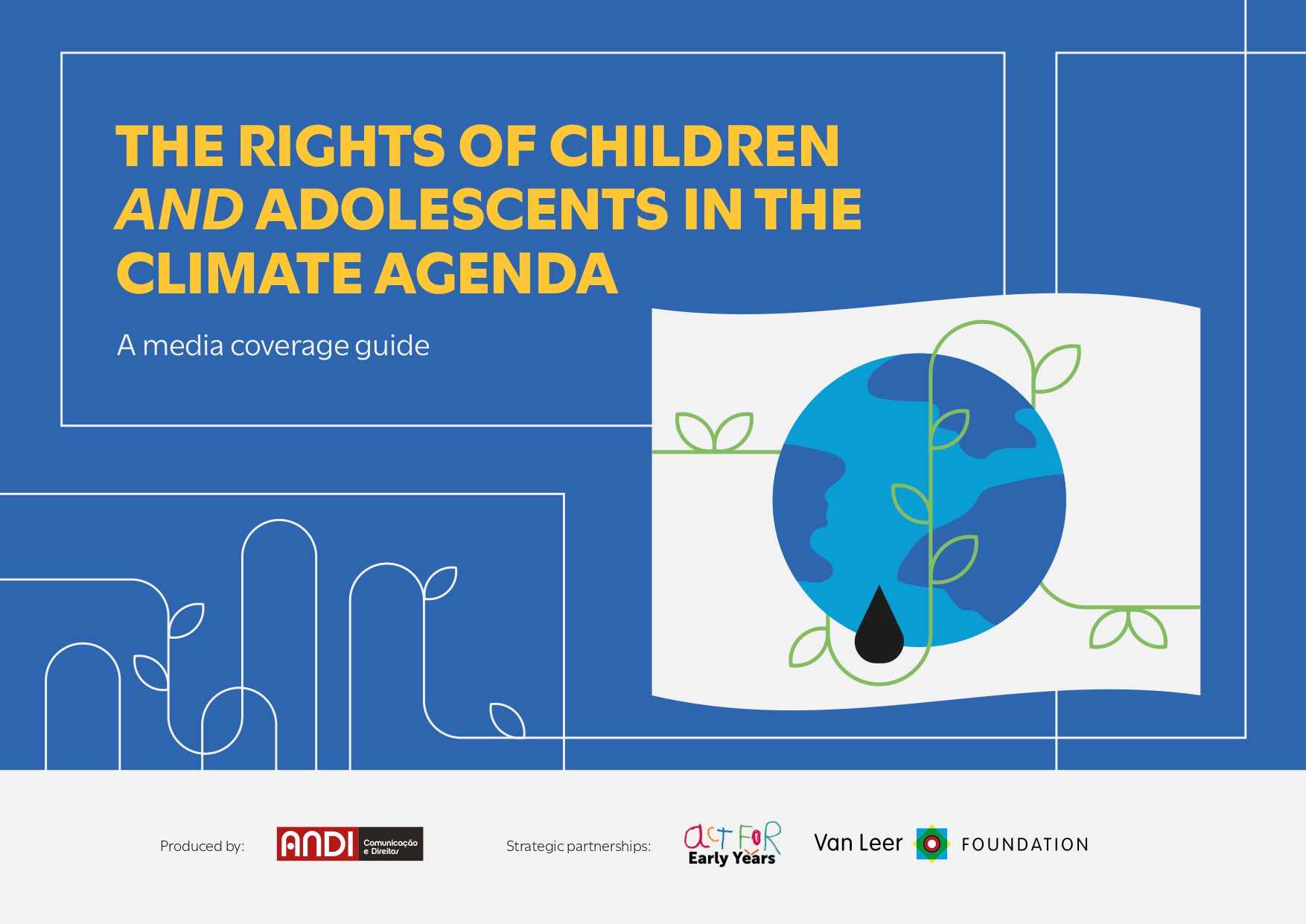
The rights of children and adolescents in the climate agenda
(2025)

Realização:
ANDI – Comunicação e Direitos
Parceiros estratégicos: Act For Early Years e Fundação Van Leer
(737,20 KB)
The climate crisis is the greatest global challenge of our time, disproportionately affecting those who have contributed least to the problem: children and adolescents. Given this reality, ANDI offers this guide to help broaden the discussion on the intersection between children’s rights and climate change, journalists, communicators, content creators, and other interested professionals
with resources to address the topic with accuracy and sensitivity.
WHY?
Children and adolescents are among the most vulnerable group to climate change due to their physical and emotional development, which increases their sensitivity to environmental impacts, such as extreme weather, food insecurity, and displacement. Similarly, because of their status they rely heavily on the existence and effectiveness of public policies and protection systems.
However, notwithstanding their vulnerability, this population segment remains largely overlooked in major global climate negotiations and agreements, and by Brazilian climate policies. Opportunities for children and adolescents to take a lead role in climate policy – not just as victims, but as change agents – are still scarce.
The discussions, targets, and global commitments shaped by the United Nations Climate Change Conferences (COPs) influence policy decisions at national and local levels. Yet, without a dedicated focus on children and adolescents, these efforts risk overlooking their unique vulnerabilities and needs — potentially compounding existing risks.
Other international instruments, such as the Convention on the Rights of the Child, establish guidelines to ensure that the rights of children and adolescents are respected and now include provisions on climate change. However, the challenges posed by global warming put these rights at risk, requiring that climate policy definitively incorporate the perspective of children.
As the climate crisis deepens, the persistent threats to the rights and safety of children and adolescents highlight the urgent need for focused societal engagement with the youngest population segments. Journalists, communicators, and content creators are pivotal to this effort: shaping narratives that connect the sweeping scope of international agreements with local childhood realities and critically examining policy responses across sectors.
Supporting news coverage of the COP
The 30th United Nations Climate Change Conference (COP 30) hosted by Brazil represents a unique opportunity to spotlight the issue in global discussions. For the first time, the country will
host the primary global decision-making forum on our climate future. It is a moment that serves to amplify the importance of the issue for society and the news media alike, creating a favorable
environment for promoting deeper engagement on how climate change puts the rights of children and adolescents at risk – and how environmental policies, global, national, and local, relate to
this age group.
This guide was also prepared to support communications professionals in this effort. Given the expectation that for many journalists COP 30 will represent their first international climate
negotiation event, the pages below are designed to meet two objectives:
- Provide a launch point for covering COP 30 with a focus on child and adolescent rights by offering insight into the structure and processes of the conference and explaining how
children and adolescents are–or are not–encompassed under international climate negotiations. - Offer contextualized information on the relationship between climate change and childhood, consolidating, in a single source, essential data to address the impacts of the crisis on this age group, including the vulnerabilities involved, rights at risk, and national and local policies, with particular attention to Brazil.
Tips and story angles
In addition, the guide includes tips for covering the conference, alerts on issues with the potential to yield good stories, and suggestions on key topics for ongoing follow-up. It also features an
information database of organizations operating at the intersection of childhood and climate, organizations specialized in international climate negotiations, and organizations of children and
adolescents at the forefront of the struggle for climate justice.
We hope this guide will be used beyond the heady days of COP 30 and serve as a resource for ongoing coverage. Through the pages that follow, ANDI reaffirms its commitment to promote human rights, child and youth rights and socio-environmental rights, as well as to provide journalists with meaningful support on how to address the challenges at the intersection of children’s rights and climate change with the appropriate accuracy and sensitivity.
We invite you to explore, learn about the topic, and put into practice the content ideas introduced in the pages below, with a consistent focus on deepening the analysis and raising awareness of the importance of protecting the rights of children and adolescents in the era of climate change.
Miriam Pragita and Ana Potyara
Directors of ANDI

